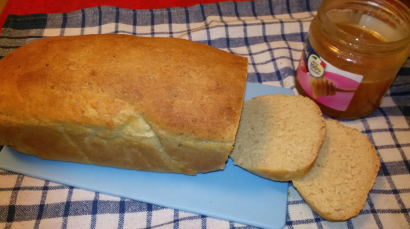No Reviews
You must be logged in to post a review.

Flour, yeast, water and salt—a traditional loaf needs only four ingredients. So why are calcium propionate, amylase, chlorine dioxide and L-cysteine hydrochloride now crammed into our daily bread?
Over the last year, I’ve gradually moved more towards making my own food at home. There are several reasons for this: it tastes better, it reduces preservative intake, it’s more nutritious, and it’s cheaper.
Dissolve the yeast in a little of water by stirring it gently with your fingers. You should stir until there are no lumps in the yeast. Pour the yeasty water into the bowl with the flour and salt and add the rest of the water. Use one hand to hold the bowl and the other to begin mixing the dough (you could use a wooden spoon but it’s just another thing to wash, and hands are more effective). Mix until the flour has absorbed the water and the gluten structure begind to develop.
Grab the dough ball out of the bowl, slap it down on the table, and start beating on it. Do this for 10 minutes. Just take the dough, punch it flat, then fold it back up into a ball again, and repeat several times. Knead for 10–15 minutes. If you are using a mixer, less time will be needed. The dough should be soft, slightly silky to the touch and elastic.
Roll the dough into a log and place in a greased bread tin. The roll should be roughly the same size as the bread pan. Cover with a cloth and let proof in a warm place (I put it in an unlit oven) for 2 hours.
Preheat oven to 400ºF (200ºC) and bake for 30–40 minutes. When done, remove from heat and immediately take bread out of the pan to cool. Let it cool down completely before slicing.
No Comments
Leave a Comment!
You must be logged in to post a comment.